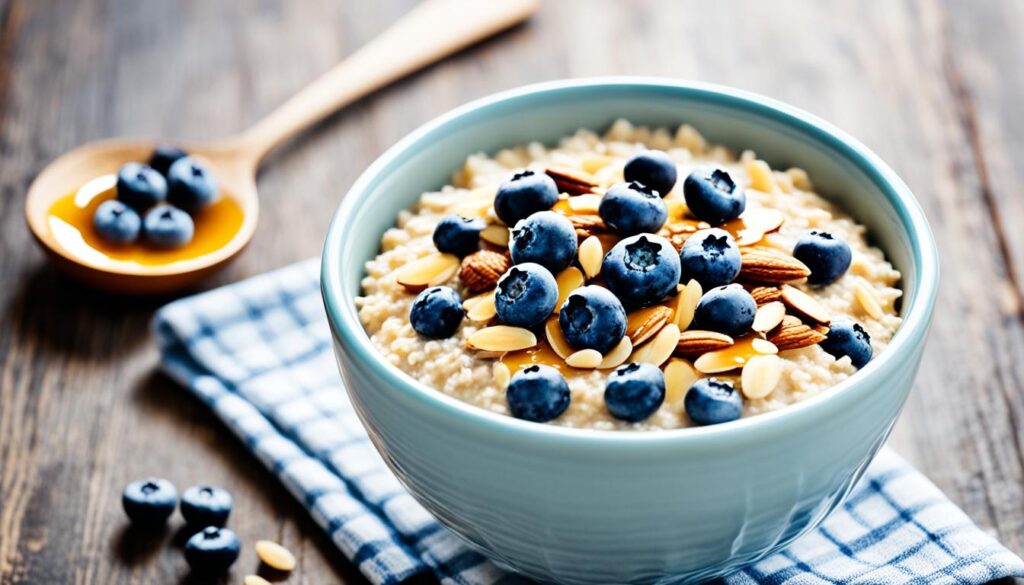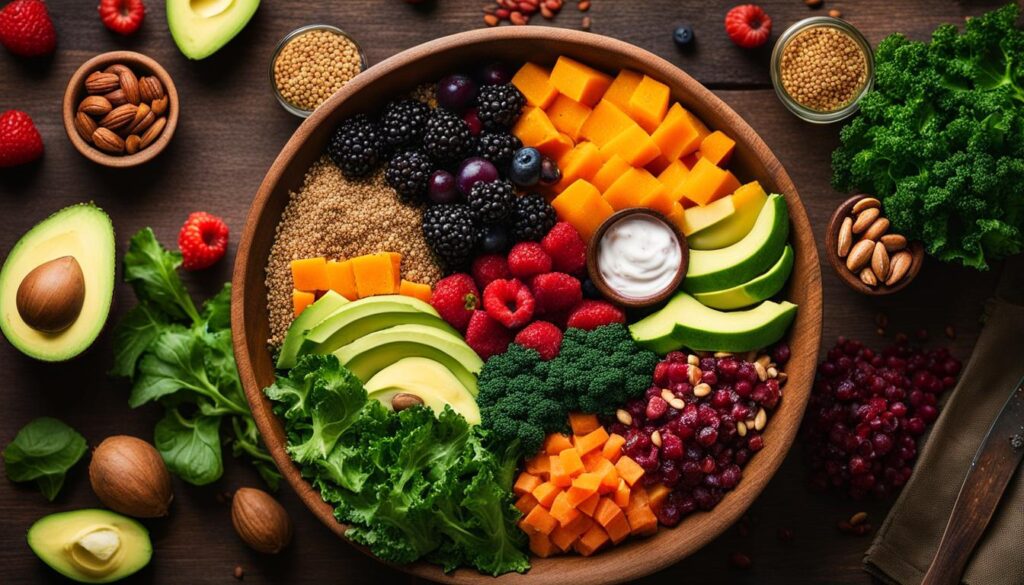Are you following a gluten-free diet and looking for nutrient-dense foods to support your overall health? Look no further. In this article, I will introduce you to the top gluten-free superfoods that provide essential vitamins, minerals, and fiber. These superfoods not only taste great but also offer a range of benefits, from boosting your energy levels to aiding in weight loss. Let’s dive in and discover the power of these gluten-free superheroes!
Key Takeaways:
- Discover the top gluten-free superfoods that can enhance your well-being.
- Learn about the benefits of incorporating these nutrient-dense foods into your diet.
- Find gluten-free superfood recipes to enjoy these foods in delicious and creative ways.
- Explore the potential benefits of organic gluten-free superfoods for your health.
- Uncover how gluten-free superfoods can support your weight loss journey.
Dried Blueberries: A Nutrient-Dense Snack
Dried blueberries are a delicious and convenient gluten-free superfood that offers numerous health benefits. These small, shriveled berries are packed with cancer-preventing antioxidants and are a great source of fiber, making them an ideal choice for a high fiber snack that supports appetite control and digestive health.
Just a quarter cup of dried blueberries provides a whopping 6 grams of fiber, which can contribute to a healthy digestive system and help regulate blood sugar levels. The fiber content of dried blueberries also promotes appetite control by keeping you feeling fuller for longer, making it easier to manage your overall calorie intake.
Aside from their high fiber content, dried blueberries are a powerhouse of cancer-preventing antioxidants. Antioxidants play a crucial role in neutralizing harmful free radicals in the body, thereby reducing the risk of chronic diseases, including cancer. Incorporating dried blueberries into your diet is a simple and delicious way to boost your antioxidant intake.
| Nutritional Information | Per 100g |
|---|---|
| Calories | 338 |
| Protein | 2.4g |
| Total Fat | 0.6g |
| Total Carbohydrate | 84g |
| Fiber | 14g |
Dried blueberries can be enjoyed on their own as a tasty snack or incorporated into various recipes. Sprinkle them over yogurt, oatmeal, or cereal for an added burst of flavor and a nutritious boost. You can also use dried blueberries to create a homemade trail mix by combining them with nuts and a few dark chocolate chips for a satisfying and energizing snack.
Next time you’re looking for a wholesome and satisfying gluten-free snack, reach for a handful of dried blueberries. Not only will they satisfy your sweet cravings, but they’ll also provide you with a delicious and nutritious way to support your overall wellbeing.
Oatmeal: A Nutritious Gluten-Free Grain
Oatmeal is a versatile and nutritious gluten-free grain that offers a range of health benefits. Packed with essential nutrients like iron, thiamine, and manganese, oatmeal provides the necessary fuel for the body’s optimal functioning.
Iron is a vital mineral that plays a key role in red blood cell production, ensuring adequate oxygen transportation throughout the body. A 1/3 cup serving of oatmeal contains more than half of a child’s daily iron requirements, making it an excellent choice for promoting healthy blood circulation and preventing iron-deficiency anemia.
Thiamine, also known as vitamin B1, is crucial for converting carbohydrates into energy, supporting proper brain function and regulating the nervous system. Gluten-free oatmeal serves as a valuable source of thiamine, ensuring consistent energy levels and cognitive well-being.
Manganese, an essential trace mineral, contributes to bone development and wound healing. When consumed as part of a balanced diet, oatmeal provides a natural source of manganese, promoting strong bone structure and facilitating the body’s natural healing mechanisms.
Gluten-Free Oat Bars Recipe
If you’re looking for a delicious and nutritious gluten-free snack, try making homemade oat bars using gluten-free oats. Here’s a simple recipe to get you started:
- In a large bowl, combine 2 cups of gluten-free oats, 1/2 cup of almond butter, 1/4 cup of honey, 1/4 cup of chopped nuts (such as almonds or walnuts), and 1/4 cup of dried fruits (such as cranberries or raisins).
- Mix everything together until well combined.
- Press the mixture firmly into a lined baking dish.
- Place the dish in the refrigerator for at least 2 hours to firm up.
- Once firm, remove from the refrigerator and cut into bars.
- Enjoy your homemade gluten-free oat bars as a quick and nutritious snack on the go!

Oatmeal is not only a delectable breakfast option but also a versatile ingredient that can be used in various recipes. From creamy bowls of oatmeal topped with fresh fruits and nuts to hearty oat bars packed with fiber and energy, there are countless ways to enjoy this nutritious gluten-free grain.
Canned Pumpkin: A Nutrient-Rich Squash
When it comes to gluten-free superfoods, canned pumpkin reigns supreme. This nutrient-rich squash is packed with essential vitamins, minerals, and fiber, making it a valuable addition to any gluten-free diet. Not only is canned pumpkin a delicious ingredient, but it also offers numerous health benefits.
One of the standout features of canned pumpkin is its high concentration of vitamin A. This powerful antioxidant plays a crucial role in maintaining healthy vision and promoting radiant skin. By incorporating canned pumpkin into your meals and snacks, you can boost your vitamin A intake and support these important aspects of your well-being.
In addition to vitamin A, canned pumpkin is also a good source of dietary fiber. Fiber is essential for maintaining a healthy digestive system and promoting regular bowel movements. By including canned pumpkin in your gluten-free recipes, you can increase your fiber intake and support overall digestive health.
Pumpkin Oat Muffins Recipe
If you’re looking for a tasty way to enjoy the benefits of canned pumpkin, try making pumpkin oat muffins. These gluten-free treats are not only delicious but also packed with nutrients. Here’s a simple recipe to get you started:
“These pumpkin oat muffins are the perfect gluten-free snack. Packed with fiber, vitamin A, and the wholesome goodness of oats, they are a healthy and satisfying treat for any time of day. Enjoy them on their own or with a cup of hot tea for a comforting and nutritious snack.”
| Ingredients | Instructions |
|---|---|
|
|
These pumpkin oat muffins are not only gluten-free but also packed with the goodness of canned pumpkin, making them a nutritious option for any time of day. Whether you’re looking for a quick breakfast on the go or a satisfying afternoon snack, these muffins are sure to hit the spot.
Flax Seeds: A Source of Fiber and Omega-3 Fatty Acids
Flax seeds are considered one of the top gluten-free superfoods, thanks to their impressive nutritional profile. These tiny seeds are rich in both fiber and omega-3 fatty acids, making them a valuable addition to any diet.
Just one tablespoon of flax seeds provides a whopping three grams of fiber, which is essential for a healthy digestive system and can help promote regularity. Additionally, flax seeds are a fantastic source of omega-3 fatty acids, which have been linked to numerous health benefits, including reducing inflammation and supporting heart health.
To fully harness the benefits of flax seeds, it’s recommended to coarsely grind them before consumption. This enhances the release of the beneficial omega-3 fatty acids and makes it easier for our bodies to absorb the nutrients.
There are various ways to incorporate flax seeds into our daily meals and snacks. Sprinkle them on top of yogurt or oatmeal for an added crunch and nutritional boost. They can also be incorporated into recipes like pancake batter, where their nutty flavor adds a delightful twist. Another creative use for flax seeds is as an egg substitute in recipes. By mixing one tablespoon of ground flaxseed with three tablespoons of water, we can create a “flax egg” that works great as a binding agent in baking.
Incorporating flax seeds into our gluten-free diet not only adds a significant amount of fiber and omega-3 fatty acids but also adds texture and flavor to our meals. So why not give these tiny seeds a try and start enjoying their numerous health benefits?

